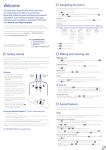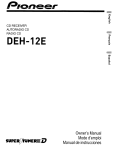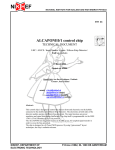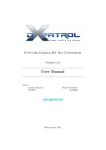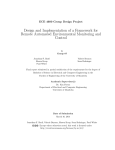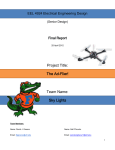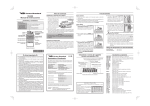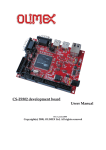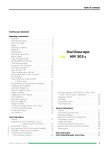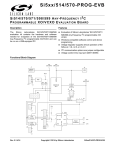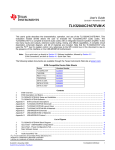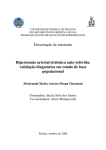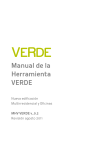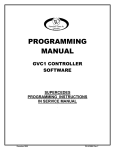Download Emic 2 Text-to-Speech Module (#30016)
Transcript
Web Site: www.parallax.com Forums: forums.parallax.com Sales: [email protected] Technical: [email protected] Office: (916) 624-8333 Fax: (916) 624-8003 Sales: (888) 512-1024 Tech Support: (888) 997-8267 Emic 2 Text-to-Speech Module (#30016) Designed in conjunction with Grand Idea Studio (www.grandideastudio.com), the Emic 2 Text-to-Speech Module is an unconstrained, multi-language voice synthesizer that converts a stream of digital text into natural sounding speech output. Using the universally recognized DECtalk text-to-speech synthesizer engine, Emic 2 provides full speech synthesis capabilities for any embedded system via a simple command-based interface. Features High-quality speech synthesis for English and Spanish languages Nine pre-defined voice styles comprising male, female, and child Dynamic control of speech and voice characteristics, including pitch, speaking rate, and word emphasis Industry-standard DECtalk text-to-speech synthesizer engine (5.0.E1) On-board audio power amplifier and 1/8” (3.5 mm) audio jack Single row, 6-pin, 0.1” header for easy connection to a host system Key Specifications Power requirements: +5 VDC, 30 mA idle, 46-220 mA active (depending on speech parameters and output load) Communication: asynchronous 9600 bps serial Operating temperature: -20 to +70 °C (-4 to +158 °F) Dimensions: 1.25” W x 1.5” L x 0.37” H (3.17 W x 3.81 L x 0.94 H cm) Application Ideas Reading Internet-based data streams (such as e-mails or Twitter feeds) Conveying status or sensor results from robots, scientific equipment, or industrial machinery Language learning or speech aids for educational environments Copyright © Parallax Inc. Emic 2 Text-to-Speech Module (#30016) v1.1 7/2/2012 Page 1 of 12 Connections Emic 2 interfaces to a host microcontroller or computer system using only four connections (GND, 5V, SOUT, SIN). Additional connections (SP+, SP-) are available for direct interfacing to an 8Ω speaker. A 1/8” (3.5mm) audio jack provides a single-ended, monaural output for easy connection to headphones, amplified speakers, or other audio equipment. Pin Pin Name Type Function 1 GND G System ground. Connect to power supply’s ground (GND) terminal. 2 5V P System power, 5 VDC input. Serial output to host. 5 V TTL-level interface, 9600 bps, 8 data bits, no parity, 1 stop bit, non-inverted. Serial input from host. 3.3 V to 5 V TTL-level interface, 9600 bps, 4 SIN I 8 data bits, no parity, 1 stop bit, non-inverted. Differential audio amplifier output, bridge-tied load configuration, 5 SPO negative side. Connect directly to 8 Ω speaker. Differential audio amplifier output, bridge-tied load configuration, 6 SP+ O positive side. Connect directly to 8 Ω speaker. Type: I = Input, O = Output, P = Power, G = Ground 3 SOUT O Use the following example circuit for connecting the Emic 2 Text-to-Speech Module: *Note: For audio output, a connection needs to be made to either SP+/SP- or the 1/8" audio jack. Audio quality may be affected if both outputs are used at the same time. Copyright © Parallax Inc. Emic 2 Text-to-Speech Module (#30016) v1.1 7/2/2012 Page 2 of 12 Usage Emic 2 is controlled by the host via a serial communications interface. To use, simply send the desired command to Emic 2 and listen for audio output from the SP+/SP- speaker connection or 1/8” audio jack. The serial interface is configured for 9600 bps, 8 data bits, no parity, 1 stop bit (8N1). When Emic 2 is ready to receive commands, it will send a “:” to the host. It will then wait in an idle state until it receives a valid command, at which time it performs the command and returns any command-specific response. Emic 2 will return a “?” upon receiving an invalid command. On power-up, Emic 2 loads its default text-to-speech settings consisting of voice type, audio volume, speaking rate, language, and parser. These settings can be configured by the user to vary the audio output. See the Command Set section below for more details. Status Indicator A visual indication of Emic 2’s operating state is given with the on-board light-emitting diode (LED): 1. Green: Idle state. Waiting for a valid command to be sent by the host. 2. Red: Active state. For example, during a text-to-speech conversion. 3. Orange (Solid): Initialization state. Occurs on power-up only. Emic 2 takes approximately three seconds to properly initialize on power-up before it is ready to receive commands. 4. Orange (Blinking): Error state. Emic 2 has malfunctioned due to an on-board communication error. If a power cycle of Emic 2 does not remedy the situation, please contact Parallax technical support for further assistance. If the LED is OFF, Emic 2 may not be receiving power. Command Set All commands are ASCII-based printable characters and are not case-sensitive (upper case and lower case will both work). Each command must be terminated with a CR or LF. Sx Dx X Z Nx Vx Wx Lx Px R C I H Convert text-to-speech: x = message (1023 characters maximum) Play demonstration message: x = 0 (Speaking), 1 (Singing), 2 (Spanish) Stop playback (while message is playing) Pause/un-pause playback (while message is playing) Select voice: x = 0 to 8 Set audio volume (dB): x = -48 to 18 Set speaking rate (words/minute): x = 75 to 600 Select language: x = 0 (US English), 1 (Castilian Spanish), 2 (Latin Spanish) Select parser: x = 0 (DECtalk), 1 (Epson) Revert to default text-to-speech settings Print current text-to-speech settings Print version information Print list of available commands Copyright © Parallax Inc. Emic 2 Text-to-Speech Module (#30016) v1.1 7/2/2012 Page 3 of 12 Command Details Sx: Convert text-to-speech Convert the passed text string into synthesized speech. The text string is limited to 1023 characters and should terminate on a clause or sentence boundary as indicated by a full stop '.' or comma ',' punctuation mark. If the text is longer than the allowable limit, it will be truncated and may result in unintelligible speech output. Emic 2 expects characters that conform to the ISO-8859-1 Latin character set (http://en.wikipedia.org/wiki/ISO/IEC_8859-1). See the Special Characters section (p. 9) for details on entering accents, foreign characters, and symbols. The audio will be output from both the SP+/SP- speaker connection and 1/8” audio jack. The LED will remain RED while the text-to-speech message is being played. Example: :SHello there! My name is Emic 2. Nice to meet you. <audio output> : Dx: Play demonstration message Play one of Emic 2’s built-in demonstration messages: 0: English Introduction 1: Singing “Daisy Bell” (http://en.wikipedia.org/wiki/Daisy_Bell) 2: Spanish Introduction Note that each demonstration message is fixed with specific voice, audio volume, speaking rate, language, and parser settings and cannot be modified by the user. All user-configured settings will be saved prior to demonstration playback and restored afterwards. See the Sample Text Strings section (p. 9) for the actual text strings used for these demonstration messages. Example: :D0 <audio output> : X: Stop playback (while message is playing) Immediately stop the currently playing text-to-speech message. This command is only valid while a message is playing. Example: :D0 <audio output> X : Copyright © Parallax Inc. Emic 2 Text-to-Speech Module (#30016) v1.1 7/2/2012 Page 4 of 12 Z: Pause/unpause playback (while message is playing) Immediately pause or unpause the currently playing text-to-speech message. Emic 2 will respond with a “.” indicating that the command has successfully been received. While the playback is paused, the LED will remain RED. This command is only valid while a message is playing. Example: :D0 <audio output> Z. <playback paused> Z. <audio output> : Nx: Select voice Select the speaking voice: 0: 1: 2: 3: 4: 5: 6: 7: 8: Perfect Paul (Paulo) Huge Harry (Francisco) Beautiful Betty Uppity Ursula Doctor Dennis (Enrique) Kit the Kid Frail Frank Rough Rita Whispering Wendy (Beatriz) Each voice has a different baseline amplitude. As such, your volume settings may need to be adjusted to suit your particular application. This setting will remain in effect until another value is entered or Emic 2 is powered off. Upon power-up, the default value is 0 (Paul). Example: :N5 : Vx: Set audio volume (dB) Set the audio output volume in decibels from -48 (softest) to 18 (loudest). This setting will remain in effect until another value is entered or Emic 2 is powered off. Upon power-up, the default value is 0. Example: :V-10 : Copyright © Parallax Inc. Emic 2 Text-to-Speech Module (#30016) v1.1 7/2/2012 Page 5 of 12 Wx: Set speaking rate (words/minute) Set the speaking rate in words per minute from 75 (slowest) to 600 (fastest). This setting will remain in effect until another value is entered or Emic 2 is powered off. Upon power-up, the default value is 200. Example: :W150 : Lx: Select language Select the language and/or dialect to be used for text-to-speech conversion: 0: US English 1: Castilian Spanish 2: Latin Spanish This setting will remain in effect until another value is entered or Emic 2 is powered off. Upon power-up, the default value is 0 (US English). Example: :L2 : Px: Select parser Select the text parsing engine to be used during text-to-speech conversion: 0: DECtalk 1: Epson See the Parser Selection section (p. 8) for usage information and parser details. This setting will remain in effect until another value is entered or Emic 2 is powered off. Upon power-up, the default value is 1 (Epson). Example: :P0 : R: Revert to default text-to-speech settings Resets the user-configurable text-to-speech settings to their default, power-up configuration: Voice = 0 (Paul) Volume = 0 dB Rate = 200 words/minute Language = 0 (US English) Parser = 1 (Epson) Copyright © Parallax Inc. Emic 2 Text-to-Speech Module (#30016) v1.1 7/2/2012 Page 6 of 12 Example: :R : C: Print current text-to-speech settings Displays the current values of the user-configurable text-to-speech settings. Example: :C Emic 2 Text-to-Speech Settings: Voice = 3 (Ursula) Volume = 0 dB Rate = 160 words/minute Language = 0 (US English) Parser = 0 (DECtalk) : V: Print version information Displays version information for the Emic 2 Text-to-Speech Module. This data is useful for troubleshooting and debugging. EMIC FW: Firmware version (major.minor) S1V30120 HW and FW: Hardware and firmware version (major.minor.revision) of the Epson S1V30120 Voice Guidance IC used on-board Emic 2 Example: :V Parallax Emic 2 Text-to-Speech Module Designed by Grand Idea Studio [www.grandideastudio.com] Manufactured and distributed by Parallax [[email protected]] EMIC FW = 1.0 S1V30120 HW = 4.2 S1V30120 FW = 2.1.6 [0x2551_25] : H: Print list of available commands Lists all available commands for the Emic 2 Text-to-Speech Module. Example: :H Emic 2 Command List: Sx Convert text-to-speech: x = message (1023 byte maximum) Dx Play demonstration message: x = 0 (Speaking), 1 (Singing), 2 (Spanish) < more commands listed, but not shown in this example > : Copyright © Parallax Inc. Emic 2 Text-to-Speech Module (#30016) v1.1 7/2/2012 Page 7 of 12 Parser Selection Emic 2 provides a choice of text parsing engines: Epson or DECtalk. Both will process incoming text strings and generate synthesized speech, but there are differences in control and customization of the resulting output. Each parser's specific functionality is incompatible with the other. Choosing which parser to use ultimately depends on what sort of speech output you desire for a particular text string. See the Sample Text Strings section (p. 9) using specific features of the Epson and DECtalk parsers. Epson Parser The Epson parser is the default setting upon Emic 2 power-up. It allows on-the-fly, dynamic changes of emphasis, pitch, voice selection, and speaking rate to take place within a text using embedded mark-up control symbols: \/ /\ >> << __ ## :-)x Decrease pitch Increase pitch Increase speaking rate Decrease speaking rate Emphasize the next word Whisper the next word Select voice (x = 0-8) (See the “Nx” command in the Command Set section (p. 5) for corresponding voice names) DECtalk Parser The DECtalk parser is intended for advanced users and allows the finest control and customization of speech output by providing direct access to the internal parameters of the DECtalk 5.0.E1 text-to-speech synthesizer engine. Dynamic customization using the DECtalk parser requires the correct usage of specialized commands and their associated parameters. Incorrect usage of the DECtalk commands may result in improper or unintelligible speech output. Please refer to the Epson/Fonix DECtalk 5.0.E1 User Manual available on the Emic 2 product page for full command details and phonetic symbols. Only a subset of the DECtalk commands are supported by the Emic 2 Text-to-Speech Module: [:comma] [:dv] [:mode] [:name] [:period] [:phoneme] [:pitch] [:pronounce] [:punct] [:rate] [:say] [:skip] [:sync] Copyright © Parallax Inc. Set the length of a comma pause (in milliseconds) Customize voice parameters (save option not supported) Set how text is processed/parsed (no e-mail parsing supported) Set the current speaking voice (numbers only: 0-8) Set the length of a period pause (in milliseconds) Enable phonemic interpretation of subsequent text Modify the pitch of uppercase letters Set the type of pronunciation for the subsequent word Set how punctuation marks are handled Set speaking rate Specify when speaking begins Skip a selected part of text pre-processing Makes a command synchronous to allow it to be processed before synthesis continues Emic 2 Text-to-Speech Module (#30016) v1.1 7/2/2012 Page 8 of 12 A large archive of songs intended for use with the DECtalk 4.40 or earlier text-to-speech synthesizer engine can be found at www.theflameofhope.co/SONGS.html. Some commands and/or phonemes used in the text strings may need to be modified in order to work properly with the newer DECtalk 5.0.E1 version implemented by Emic 2. Special Characters Emic 2 expects characters that conform to the ISO-8859-1 Latin character set (http://en.wikipedia.org/wiki/ISO/IEC_8859-1). Along with standard alphanumeric characters, the character set also contains accents, symbols, and foreign characters (ranging from 0xA0 to 0xFF) that may not have specific keyboard keys assigned to them. Emic 2 provides an easy method to enter single-byte hexadecimal character codes from any host by using an escape sequence “\xhh” (where hh is two hex digits). For example, to use the letter ñ (n-tilde, which has a hexadecimal value of 0xF1), enter the text “\xF1” within your text string. On the Windows operating system, if the desired character is unavailable on your keyboard, you can insert the character directly by pressing a special key combination: Hold down the ALT key and enter the four digit decimal equivalent of the character in the numeric keypad section of the keyboard. For example, for the letter ñ (n-tilde), press ALT-0241. On the Mac OS X operating system, most of the special character codes in its default MacRoman character set are not compatible with the ISO-8859-1 character set. Thus, if you try to enter special characters directly from a keyboard using OS X, Emic 2 may return an error or speak characters you were not expecting. In this case, it is recommended to use the above-mentioned escape sequence. Other operating systems may also support direct insertion of special characters. Please refer to the specific operating system documentation for details. Sample Text Strings This section contains sample text strings that demonstrate the configurability and varied speech outputs of the Emic 2 Text-to-Speech Module. To use, first ensure that the correct parser is selected. Then, copy the desired text string and pass it to Emic 2 with the “S” command. Epson Parser All 9 voices in a single text string My Emic has a :-)0 voice :-)1 voice :-)2 voice :-)3 voice:-)4 voice :-)5 voice:-)6 voice :-)7 voice:-)8 voice. English Introduction (Built-in demonstration message #0) :-)0 Hello everyone. My name is Emic 2. I am the next generation text-to-speech module created by Grand Idea Studio. I can ##whisper ##very ##quietly. I can change to 1 of 9 voices. For example, from Paul :-)1 to Harry :-)4 to Dennis :-)8 to Wendy. :-)0 I can also /\/\ increase my pitch. /\/\ And increase my pitch again. >>>> Then speak faster >>>> and even faster >>>> and even faster again. <<<<<<<<<<<< \/\/\/\/ And then go back to normal. Copyright © Parallax Inc. Emic 2 Text-to-Speech Module (#30016) v1.1 7/2/2012 Page 9 of 12 Spanish Introduction (Built-in demonstration message #2) (Language must be set to Castilian Spanish) :-)0 Hola. Me llamo Emic numero 2. Ahora puedo hablar espa\xF1ol! Soy la pr\xF3xima generacion de texto a voz modulo creado por Grand Idea Studio. Yo puedo ##susurrar ##en ##voz ##muy ##baja. Yo puedo cambiar a una de las nueve voces. Por ejemplo, de Paulo :-)1 a Francisco :-)4 a Enrique :-)8 a Beatriz. :-)0 Tambien puedo /\/\ aumentar mi tono. /\/\ y aumentar mi tono otra vez. >> Entonces hablar mas r\xE1pido. >> y aun mas r\xE1pido >> y aun mas r\xE1pido otra vez. <<<<<< \/\/\/\/ Y luego volver a la normalidad. DECtalk Parser Robotic monotone [:rate 200][:n0][:dv ap 90 pr 0] All your base are belong to us. Singing “Daisy Bell” (Built-in demonstration message #1), http://en.wikipedia.org/wiki/Daisy_Bell [:phone arpa speak on][:rate 200][:n0][dey<650,22>ziy<600,19> dey<650,15>ziy<600,10> gih<200,12>v miy<200,14> yurr<200,15> ae<400,12>nsax<200,15>r duw<750,10> _<400,10>][:n0][ay<600,17>m hxae<500,22>f kr ey<650,19>ziy<600,15> ao<200,12>ll fao<200,14>r dhax<200,15> llah<400,17>v ao<200,19>v yu<750,17> _<400,17>][:n0][ih<200,19>t wow<200,20>nt biy<200,19> ax<200,17> stay<500,22>llih<200,19>sh mae<350,17>rih<400,15>jh<150,15>][:n0][ay<200,17> kae<400,19>nt ax<200,15>fow<400,12>rd ax<200,15> kae<350,12>rih<400,10>jh<150,10>][:n0][bah<200,10>t yu<500,15>d lluh<200,19>k swiy<400,17>t ah<200,10>p ao<500,15>n dhax<200,19> siy<200,17>t ao<200,17>v ah<200,19> bay<200,22>six<200,19>kel<200,15> bih<400,17>llt fao<200,10>r tuw<800,15>][:n0] Singing “Happy Birthday” [:phone arpa speak on][:rate 200][:n0][hxae<300,10>piy<300,10> brrrx<600,12>th<100>dey<600,10>tuw<600,15> yu<1200,14>_<300> hxae<300,10>piy<300,10> brrrx<600,12>th<100>dey<600,10> tuw<600,17>yu<1200,15>_<300> hxae<300,10>piy<300,10> brrrx<600,22>th<100>dey<600,19> dih<600,15>r eh<600,14>m<100,12>ih<350,12>k_<120>_<300> hxae<300,20>piy<300,20> brrrx<600,19>th<100>dey<600,15> tuw<600,17> yu<1200,15>][:n0] Singing “The Star-Spangled Banner” (The text exceeds the maximum allowable 1023 characters per message, so it must be split into two messages) [:phone arpa speak on][:rate 100][:n0][ow<200,18>ow<200,15> sey<400,11> kae<400,15>n yu<400,18>w siy<600,23> _<300> bay<350,27> dhah<50,25> dao<400,23>nz rr<400,15>ll iy<400,17> llay<600,18>t _<300> wah<200>t sow<200> praw<600,27>dlliy<200,25> wiy<400,23> hxey<400,22>eld _<300> ae<300,20>t dhah<100,22> tway<400,23> llay<400>ts llae<400,18>st glliy<400,15>m iy<200,11>nx _<300> hxuw<300,18>z brao<100,15>d stray<400,11>ps ae<400,15>nd bray<400,18>t stah<600,23>rz _<300> thruw<300,27> dhah<100,25> peh<400,23> rrel<400,15> ah<400,17>s fay<600,18>t _<300> ow<200,18>r dhah<200,18> rrae<600,27>mpah<200,25>rts wiy<400,23> waa<600,22>cht wrr<300,20> sow<100,22> gae<400,23>llah<400>ent lliy<400,18> striy<400,15>miy<200,11>nx _<300>][:n0] Copyright © Parallax Inc. Emic 2 Text-to-Speech Module (#30016) v1.1 7/2/2012 Page 10 of 12 [:phone arpa speak on][:rate 100][:n0][ae<300,27>nd dhah<100> raa<400> keh<400,28>ts r eh<400,30>d glley<700>r _<300> dhah<100,28> baa<400,27>mz brr<400,25>stih<400,27>nx ih<400,28>n ey<600>r _<300> gey<400>v pruw<600,27>f thruw<200,25> dhah<400,23> nay<900,22>t dhae<300,20>d aw<100,22>rr fllae<400,23>g wah<400,15> stih<400,17>ll dheh<600,18>r _<300> ow<400> sey<400,23> dah<400>z dhae<200,23>ae<200,22>t stah<400,20>r spae<400>ngel<400>d bae<400,25>nrr<200,28>rr<200,27> yxeh<200,25>eh<200,23>t wey<800,23>ey<150,25>ey<150,23>ey<1200,22>v _<900> fow<300,18>rdhah<300> llae<900,23>ae<400,25>nd ah<300,27>v dhah<300,28> friy<1000,30>iy<1000,35> _<900> ae<300,23>nd dhah<300,25> hxow<1000,27>m _<600> ah<300,28>v dhah<1000,25> brrey<1500,23>v _<900>][:n0] Certain characters are not spoken The following characters are not spoken by Emic 2 during a text-to-speech conversion. If you’d like any of these specific characters to be spoken, simply use the text equivalent in your text string (For example, “less than” instead of “<”). Character ISO-8859-1 Hex Code Description Character ISO-8859-1 Hex Code Description ( 0x28 Left parenthesis ® 0xAE Registered sign < 0x3C Less than ¯ 0xAF Macron [ 0x5B Left square bracket ´ 0xB4 Acute accent { 0x7B Left curly bracket ¸ 0xB8 Cedilla | 0x7C Vertical bar º 0xBA Masculine ordinal indicator NBSP 0xA0 No-break space Ð 0xD0 Latin capital letter eth ¤ 0xA4 Currency sign × 0xD7 Multiplication sign ¦ 0xA6 Broken bar Þ 0xDE Latin capital letter thorn ¨ 0xA8 Diaeresis ÷ 0xF7 Division sign ¬ 0xAC Not sign þ 0xFE Latin small letter thorn SHY 0xAD Soft hyphen ÿ 0xFF Latin small letter y with diaeresis Copyright © Parallax Inc. Emic 2 Text-to-Speech Module (#30016) v1.1 7/2/2012 Page 11 of 12 Electrical Characteristics At VCC = +5.0V and TA = 25ºC unless otherwise noted Parameter Symbol Test Conditions Supply Voltage VCC Supply Current, Idle IIDLE Supply Current, Active Specification Unit Min. Typ. Max. --- 3.6 5.0 5.5 V --- --- 30 --- mA ICC Demo #0, RL = 8 Ω Volume = -38dB Volume = 0dB Volume = +18dB ------- ------- 46 65 220 mA SP+/SP- Continuous Average Output Power PO RL = 8 Ω --- --- 300 mW Audio Jack Impedance JL No load --- 10 --- Ω JVPP Demo #0, No load Volume = -38dB Volume = 0dB Volume = +18dB ------- ------- 0.85 1.75 4.1 V JVPK Demo #0, No load Volume = -38dB Volume = 0dB Volume = +18dB ------- ------- 0.4 1.0 2.5 V Audio Jack Peak-to-Peak Output Voltage Audio Jack Peak Output Voltage Absolute Maximum Ratings Condition Value Operating Temperature -20ºC to +70ºC (-4ºF to +158ºF) Storage Temperature -55ºC to +125ºC (-67ºF to +257ºF) Supply Voltage (VCC) +6.0V Ground Voltage (VSS) 0V NOTICE: Stresses above those listed under Absolute Maximum Ratings may cause permanent damage to the device. This is a stress rating only and functional operation of the device at those or any other conditions above those indicated in the listings of this specification is not implied. Exposure to maximum rating conditions for extended periods may affect device reliability. Open Source Files and Example Code The following engineering materials are released as open source under a Creative Commons Attribution 3.0 United States license (http://creativecommons.org/licenses/by/3.0/us/), allowing free distribution and reuse. The materials are posted on the Emic 2 product page; search “30016” at www.parallax.com: Schematic Bill-of-Materials Assembly Drawing Example Code for BASIC Stamp 2, Propeller P8X32A, and Arduino Uno Revision v1.1: Updated note below connection diagram and added row 6 to Connections table; page 2. Copyright © Parallax Inc. Emic 2 Text-to-Speech Module (#30016) v1.1 7/2/2012 Page 12 of 12 Emic 2 Text-to-Speech Module (Parallax #30016) Bill-of-Materials HW A, Document 1.0, March 8, 2012 Notes: 1) Do not populate: J3 Item 1 2 3 4 5 6 7 8 9 10 11 12 13 14 15 16 17 18 19 20 21 22 23 24 25 26 27 28 29 30 31 32 33 34 35 Quantity Reference C1, C2, C6, C7, C8, C10, C15, C16, C17, C18, C19, C20, C21, C23, C31, C32, 20 C33, C34, C35, C36 5 C3, C22, C24, C27, C37 6 C4, C5, C14, C25, C26, C28 2 C9, C29 2 C11, C30 1 C12 2 C13, C38 1 C39 1 D1 1 J1 1 J2 3 L1, L2, L3 1 L4 2 R1, R9 4 R2, R3, R4, R5 1 R6 1 R7 1 R8 2 R10, R19 1 R11 2 R12, R16 1 R13 1 R14 1 R15 1 R17 1 R18 1 R20 1 U1 1 U2 1 U3 1 U4 1 U5 1 U6 1 Y1 1 PCB Manufacturer Manuf. Part # Distributor Distrib. Part # Description Kemet TDK Kemet TDK TDK TDK Kemet Murata Kingbright Molex CUI Murata TDK Any Any Any Any Any Any Any Any Any Any Any Any Any Any Freescale Texas Instruments Micrel Micrel Epson National Epson e-Teknet C0603C104K4RACTU C1608X7R1C105K T491A106M016AS C1608X7R1H471K C1608X7R1H103K C1608X7R1H102K C0603C224K4RACTU GRM188R71H473KA61D APB3025ESGC-F01 22-28-4060 SJ-3523-SMT BLM41PF800SN1L MLZ2012A3R3W Any Any Any Any Any Any Any Any Any Any Any Any Any Any MCF51QE128CLH PCA9306DCTR MIC5205-3.3YM5 MIC5205YM5 S1V30120F01A100 LM4864MM SG-3030JC 32.7680KB3:ROHS EMIC2 Digi-Key Digi-Key Digi-Key Digi-Key Digi-Key Digi-Key Digi-Key Digi-Key Mouser Digi-Key Digi-Key Digi-Key Digi-Key Digi-Key Digi-Key Digi-Key Digi-Key Digi-Key Digi-Key Digi-Key Digi-Key Digi-Key Digi-Key Digi-Key Digi-Key Digi-Key Digi-Key Future Digi-Key Digi-Key Digi-Key Future Digi-Key Future N/A 399-1096-1-ND 445-1604-1-ND 399-3687-1-ND 445-1307-1-ND 445-1311-1-ND 445-1308-1-ND 399-5619-1-ND 490-3287-1-ND 604-APB3025ESGC-F01 WM6406-ND CP-3523SJCT-ND 490-1059-1-ND 445-6394-1-ND P200KGCT-ND P4.7KGCT-ND P10KGCT-ND P270GCT-ND P470GCT-ND P47KGCT-ND P22KGCT-ND P51KGCT-ND P1.5KGCT-ND P15KGCT-ND P2.2KGCT-ND P220KHCT-ND P100KHCT-ND P10GCT-ND N/A 296-18509-1-ND 576-1259-1-ND 576-1262-1-ND N/A LM4864MMTR-ND N/A N/A 0.1uF ceramic capacitor, 16V, X7R, 0603 1.0uF ceramic capacitor, 16V, X7R, 0603 10uF capacitor, 20%, 16V, tantalum, size A 470pF ceramic capacitor, 50V, X7R, 0603 10000pF ceramic capacitor, 50V, X7R, 0603 1000pF ceramic capacitor, 50V, X7R, 0603 0.22uF ceramic capacitor, 16V, X7R, 0603 0.047uF ceramic capacitor, 50V, X7R, 0603 Red/Green Bi-Color LED, 1201W SMT Header, Single row, Vertical, 6-pin, 0.1” P Connector, Audio Jack, 3.5mm, Stereo, SMD Ferrite Chip, 80R @ 100MHz, 1A, 1806 Inductor, 3.3uH, 340mR, 200mA, 0805 200k, 5%, 1/10W, 0603 4.7k, 5%, 1/10W, 0603 10k, 5%, 1/10W, 0603 270 ohm, 5%, 1/10W, 0603 470 ohm, 5%, 1/10W, 0603 47k, 5%, 1/10W, 0603 22k, 5%, 1/10W, 0603 51k, 5%, 1/10W, 0603 1.5k, 5%, 1/10W, 0603 15k, 5%, 1/10W, 0603 2.2k, 5%, 1/10W, 0603 220k, 1%, 1/10W, 0603 100k, 1%, 1/10W, 0603 10 ohm, 5%, 1/10W, 0603 Microcontroller, Coldfire, TQFP-64 Voltage-Level Translator, SM8 Linear Regulator, LDO, 3.3V, 150mA, SOT23-5 Linear Regulator, LDO, Adjustable, 150mA, SOT23-5 IC, Text-to-Speech Synthesizer, TQFP-64 IC, Audio Amplifier, 300mW typical, MSOP-8 Oscillator, 32.768kHz, +/-23ppm, 1.5V-5.5V, SMD PCB, Fabrication 1 2 3 4 5 6 5V0 A A COU1 U1 PIR102 MCF51QE128CLH COR1 R1 5V0 PIJ102 PIJ101 PTB0/KBIP4/RXD1/ADP4 PTB1/KBIP5/TXD1/ADP5 32 PIU1032 PTB2/KBI1P6/SPSCK1/ADP6 31 PIU1031 PTB3/KBI1P7/MOSI1/ADP7 19 PIU1019 PTB4/TPM2CH1/MISO1 18 PIU1018 PTB5/TPM1CH1/SS1 13 PIU1013 PTB6/SDA1/XTAL 12 PIU1012 PTB7/SCL1/EXTAL 33 PIU1033 43 42 PIU1042 36 PIU1036 35 PIU1035 30 PIU1030 29 PIU1029 28 PIU1028 27 PIU1027 PIU1043 B Background Debug Mode (BDM) COJ3 J3 3V3 PIR601 3V3 PIJ303 NLBKGD BKGD PIJ301 5 3 1 6 4 2 PIJ306 PIJ304 PTF0/ADP10 PTF1/ADP11 PTF2/ADP12 PTF3/ADP13 PTF4/ADP14 PTF5/ADP15 PTF6/ADP16 PTF7/ADP17 COR6 R6 NO FIT PIJ305 NL0RESET /RESET PIJ302 PIR602 COC2 C2 Header 2X3 0.1uF 10k 63 64 PIU1063 IRQ/RESET BKGD/MS VDD PIU1064 POMISO MISO POSFRM1 SFRM1 POMSGRDY MSGRDY 26 25 21 20 PIU1020 62 PIU1062 61 PIU1061 52 PIU1052 51 PIU1051 PIU1026 PIU1025 B NLLEDR LEDR NLLEDG LEDG PIU1021 PIR702 PIR802 PIR701 PID103 PIR801 PID101 COR7 R7 270 COR8 R8 470 COD1B D1B KPB-3025ESGC COD1A D1A KPB-3025ESGC Green Red PID104 PID102 PIU106 PIU104 PIU107 PIU108 PIU109 PIU10 PIU10 PIU104 6 3V3 POSCLK SCLK POMOSI MOSI 60 PTE0/RPGIO0/TPM2CLK/SPSCK1 PIU1060 59 PTE1/RGPIO1/MOSI1 PIU1059 54 PTE2/RPGIO2/MISO1 PIU1054 53 PTE3/RPGIO3/SS1 PIU1053 39 PTE4/RPGIO4 PIU1039 17 PTE5/RGPIO5 PIU1017 16 PTE6/RGPIO6 PIU1016 5 PTE7/RGPIO7/TPM3CLK PIU105 PTC0/RGPIO8/TPM3CH0 PTC1/RGPIO9/TPM3CH1 PTC2/RGPIO10/TPM3CH2 PTC3/RGPIO11/TPM3CH3 PTC4/RGPIO12/TPM3CH4/RSTO PTC5/RGPIO13/TPM3CH5/ACMP2O PTC6/RGPIO14/RXD2/ACMP2+ PTC7/RGPIO15/TXD2/ACMP2- 58 PTG0 57 PIU1057 PTG1 56 PIU1056 PTG2/ADP18 55 PIU1055 PTG3/ADP19 PIU1058 PIC202 PIC201 PTD0/KBI2P0/SPSCK2 PTD1/KBI2P1/MOSI2 PTD2/KBI2P2/MISO2 PTD3/KBI2P3/SS2 PTD4/KBI2P4 PTD5/KBI2P5 PTD6/KBI2P6 PTD7/KBI2P7 34 PIU1034 1 SDA2 NLRX RX NLTX TX PONRESET NRESET 2 PIU102 1 PIU101 46 PIU1046 45 PIU1045 44 PIU1044 24 PIU1024 23 PIU1023 22 PIU1022 2 SDA1 4 PIU204 3 PIU103 3 3 PIU203 4 PIU104 4 SCL1 SCL2 14 PIU1014 VSS 5 PIU205 37 PIU1037 PIR401 PIR501 VSS 6 PIU206 38 PIU1038 4.7k 15 PIU1015 41 POSP0 SP+ POSP0 SP- 47 PIU1047 COR5 R5 VSSAD NLSIN SIN NLSOUT SOUT 2 PIU202 COR4 R4 4.7k PTH0 PTH1 PTH6/SCL2 PTH7/SDA2 11 PIJ103 VREF1 3V3 VREFL PIJ104 VREF2 1 PIU201 PTA0/KBI1P0/TPM1CH0/ADP0/ACMP1+ PTA1/KBI1P1/TPM1CH1/ADP1/ACMP1PTA2/KBIP2/SDA1/ADP2 PTA3/KBIP3/SCL1/ADP3 PTA6/TPM1CH2/ADP8 PTA7/TPM2CH2/ADP9 9 PIJ105 7 PIU207 PIR201 PIR301 GND 48 PIU1048 10 PIJ106 0.1uF EN 49 PIU1049 VREFH 6 5 4 3 2 1 8 PIU208 50 PIU1050 PIR402 PIR502 VDDAD Header 6 4.7k 3V3 COU2 U2 PCA9306DCT COC1 C1 8 4.7k COR3 R3 200k VDD COJ1 J1 PIR101 PIC102 PIC101 7 COR2 R2 PIR202 PIR302 40 5V0 C C 10mS delay from power-up to EN @ 2V = 0.5RC Rail must go high > 10uS after 1V8 per Epson S1V30120 Power-On/Reset Timing spec. Place close to power input COU3 U3 MIC5205-3.3YM5 1 5 PIU301 IN OUT PIU305 5V0 COC3 C3 5V0 1.0uF PIR902 COR9 R9 D PIR901 PIC10 2 PIC10 1 200k PIC302 PIC301 3 PIU303 2 PIU302 3V3 COL1 L1 3V3 PIC401 PIC402 EN GND BYP 4 PIU304 PIC902 PIC901 COC9 C9 COC4 C4 10uF COC5 C5 10uF PIC501 PIC502 3V3 PIC602 PIC601 3V3 COC6 C6 0.1uF PIC702 PIC701 3V3 COC7 C7 0.1uF PIC802 PIC801 PIL101 COL2 L2 COC8 C8 0.1uF PIL201 80R@100MHz, 1A PIL102 80R@100MHz, 1A NOTE: RESISTORS ARE IN OHMS +/- 5% AND CAPACITORS ARE IN MICROFARADS UNLESS OTHERWISE NOTED. SEE BOM FOR ACTUAL VOLTAGE AND SPECIFICATION. PIL202 470pF COC10 C10 D 0.1uF TITLE Emic 2 Text-to-Speech Module (#30016) Distributed under a Creative Commons Attribution 3.0 US license DATE FILENAME 3/23/2012 1 2 3 4 SIZE B 5 SHT 1 OF 2 DRAWN BY REV Joe Grand A 6 1 2 3 4 5 6 3V3 COU5 U5 PIR1902 S1V30120F01A100 COR19 R19 3V3 46 PIU5046 52 PIU5052 53 PIU5053 54 PIU5054 55 PIU5055 58 PIU5058 59 PIU5059 60 PIU5060 48 PIU5048 47 PIU5047 1 PIU501 2 PIU502 A POMSGRDY MSGRDY 3V3 PIR10 2 COR10 R10 47k PIR10 1 PONRESET NRESET COY1 Y1 3V3 SG-3030JC 32.7680KB3 3 VCC OUT PIY103 4 PIY104 1 PIY101 VIO NLNRESET NRESET PIU5062 NLCLKI CLKI 36 PIU5036 62 GPIOA0 GPIOA1 GPIOA2 GPIOA3 GPIOA4 GPIOA5 GPIOA6 GPIOA7 GPIOA8 GPIOA9 GPIOA10 GPIOA11 SIN SOUT SCLK SFRM1 SFRM2 8 SCANEN TESTEN TSTMODE0 TSTMODE1 TSTMODE2 EXCKM NTRST TDI TMS TCK TDO VCP CLKI 49 PIU5049 56 PIU5056 64 PIU5064 3 11 20 24 PIU5024 29 PIU5029 39 PIU5039 45 PIU5045 50 PIU5050 57 PIU5057 LVDD LVDD LVDD LVDD LVDD LVDD LVDD LVDD LVDD 18 PIU5018 28 PIU5028 37 PIU5037 B 47k POMISO MISO A PIU5010 NLHPO HPO 26 PIU5026 300mW typ. @ 8 ohm BTL A3V3 17 PIU5017 21 PIU5021 22 PIU5022 31 PIU5031 30 PIU5030 NRESET HVDD HVDD HVDD HVDD HVDD HVDD HVDD PIU508 PIR1901 Bias HPO HPON HPOP AUDCLK SPPDN SPHMT 3V3 2 GND PIY102 5 PIU505 POMOSI MOSI 9 PIU509 4 PIU504 POSCLK SCLK 7 PIU507POSFRM1 SFRM1 10 2nd order low-pass filter Fc = 10kHz COR11 R11 PIR1202 22k PIR1102 PIR1101 POSP0 SP+ COR12 R12 COR13 R13 COR14 R14 1.5k PIR1302 PIR1301 PIR1402 PIU5063 PIC1 02 COC11 C11 42 PIU5042 PIC1 01 63 40 PIU5040 15k PIR1201 PIR1602 PIR1401 PIC1202 COC12 C12 0.01uF PIC1201 51k COR15 R15 PIC1302 PIC1301 PIR1502 COR16 R16 1000pF 43 PIU5043 COU6 U6 PIR1601 2.2k PIR1501 COC13 C13 0.22uF 2 PIU602 PIC1401 COC14 C14 44 38 15 PIU5015 PIC1402 3V3 -IN +IN VO1 VO2 BYPASS VDD NLSP0 SP+ NLSP0 SP- 5 PIU605 8 PIU608 PIC3802 PIC3801 A5V0 51k PIU5044 PIU5038 4 PIU604 3 PIU603 10uF 1 PIU601 SD COJ2 J2 SJ-3523-SMT COC38 C38 0.22uF LM4864MM PIR20 2 POSP0 SP- 6 PIU606 PIC1502 COC15 C15 PIC1501 0.1uF 7 GND PIU607 PIJ201 PIJ203 PIJ205 COR20 R20 10 ohm PIR20 1 PIC3902 PIC3901 14 PIU5014 COC39 C39 0.047uF 13 PIU5013 12 PIU5012 19 PIU5019 34 PIU5034 B 1V8 PIU503 PIU5011 PIU5020 6 PIU506 16 PIU5016 23 PIU5023 32 PIU5032 41 PIU5041 51 PIU5051 61 PIU5061 1V8 PLLVDD 33 PIU5033 35 PLLVSS PIU5035 AVDD PIU5027 AVSS PIU5025 A3V3 VSS VSS VSS VSS VSS VSS VSS 27 25 C C 3V3 1V8 COU4 U4 5V0 MIC5205YM5 1 PIU401 COC27 C27 1.0uF Adjustable output Vout = 1.242V x [(Rb / Rt) + 1] = 1.806V PIC2702 PIC2701 3 PIU403 2 PIU402 IN 5 OUT PIU405 GND BYP PIU404 PIR1702 PIC2801 PIC2802 COR17 R17 EN PIR1701 PIR1802 4 PIC2902 PIC2901 COC29 C29 470pF 220k, 1% COC16 C16 0.1uF PIC1802 PIC1801 COC17 C17 0.1uF 1V8 COC18 C18 0.1uF PIC1902 PIC1901 1V8 COC19 C19 0.1uF PIC20 2 PIC20 1 1V8 COC20 C20 0.1uF PIC2102 PIC2101 1V8 COC21 C21 0.1uF PIC2 02 PIC2 01 1V8 COC22 C22 1.0uF PIC2302 PIC2301 COC23 C23 0.1uF PIC2402 PIC2401 A3V3 COL4 L4 1V8 5V0 PIL402 COC24 C24 80R@100MHz, 1A PIL301 PIC2501 PIC2502 1.0uF A5V0 COL3 L3 3.3uH PIL401 PIL302 PIC2601 PIC2602 COC25 C25 10uF COC26 C26 10uF Place near oscillator PIC30 2 PIC30 1 100k, 1% PIC1702 PIC1701 1V8 1V8 3V3 COR18 R18 PIR1801 COC28 C28 10uF PIC1602 PIC1601 1V8 3V3 COC30 C30 0.01uF PIC3102 PIC3101 3V3 PIC3202 PIC3201 COC31 C31 0.1uF 3V3 COC32 C32 0.1uF PIC3 02 PIC3 01 3V3 COC33 C33 0.1uF PIC3402 PIC3401 3V3 COC34 C34 0.1uF PIC3502 PIC3501 3V3 COC35 C35 0.1uF PIC3602 PIC3601 NOTE: RESISTORS ARE IN OHMS +/- 5% AND CAPACITORS ARE IN MICROFARADS UNLESS OTHERWISE NOTED. SEE BOM FOR ACTUAL VOLTAGE AND SPECIFICATION. A3V3 COC36 C36 0.1uF PIC3702 PIC3701 COC37 C37 1.0uF D D TITLE Emic 2 Text-to-Speech Module (#30016) Distributed under a Creative Commons Attribution 3.0 US license DATE FILENAME 3/23/2012 1 2 3 4 SIZE B 5 SHT 2 OF 2 DRAWN BY REV Joe Grand A 6



















